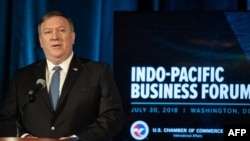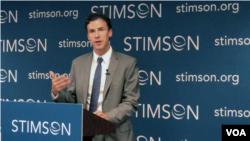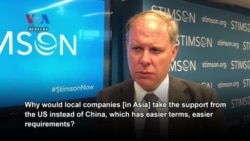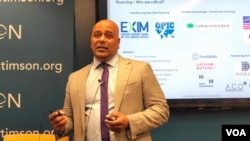WASHINGTON D.C. — A new $60-billion United States government overseas investment agency could counterbalance the surge of Chinese investment and loans in the Asia-Pacific Region, experts and officials said recently.
The experts said, however, that the U.S. should take further steps if it wants to offer development finance alternatives to Asian countries like Cambodia, which have become increasingly dependent on massive Chinese investment and loans that dominate local economies.
Conor Savoy, director of policy and advocacy at the Washington-based Global Innovation Fund, said the new agency was a U.S. effort “to more directly compete with China in these developing countries” and to offer alternative ways of financing as the U.S. believes “there are problems that go along with Chinese investment.”
America is increasingly concerned about China’s effort in the [Asia-Pacific] region, and the types of investment they are making, what it’s doing to different economies, and what it’s doing for China to advance their strategic interests.
Savoy was among a panel of experts and officials who gathered at the Stimson Center last month to discuss U.S. engagement on infrastructure and development in the Asia-Pacific Region, and they looked ahead at the creation of the International Development Finance Corp (IDFC).
On Oct. 4, the Senate passed the BUILD Act that created the IDFC. It will take over foreign finance tasks from the Overseas Private Investment Corp (OPIC) and USAID. The new agency has $60 billion in funds and will reform U.S. development financing in energy, ports and water infrastructure in developing countries with a focus on the private sector projects.
‘A clear alternative’
Clete Willems, Deputy Assistant to the President for International Economic Affairs and Deputy Director for the National Economic Council, said, “America is increasingly concerned about China’s effort in the [Asia-Pacific] region, and the types of investment they are making, what it’s doing to different economies, and what it’s doing for China to advance their strategic interests."
“And we want to find a way to provide a clear choice, to provide a clear alternative."
Chinese finance carries debt risk
The Chinese government has greatly expanded foreign loans and state-backed private investment across Asia in recent years. Beijing has focused on infrastructure development finance through its Belt & Road Initiative and the Asian Infrastructure Investment Bank (AIIB), which has drowned out the largely U.S.-supported, traditional multilateral financiers such as the World Bank and Asian Development Bank (ADB).
Many poorer countries that developed strong diplomatic ties with China have taken on massive loans, and in some countries, such as Sri Lanka, mounting debts later forced governments to cede control over infrastructure assets such as ports to China, or to repay-in-kind by providing access to natural resources.
Cambodia has accepted a massive surge of Chinese investment and loans in infrastructure and real estate in recent years. Its embrace of Beijing further tightened after relations with the U.S. and other Western governments suffered when Prime Minister Hun Sen claimed victory in an election last July that has been criticized as neither free nor fair.
US focus on private sector finance
Savoy said the new agency will not try to match China’s massive packages of government-to-government loans and state company investments for large infrastructure projects and real estate development.
As such, the new agency’s influence may be limited in scale, he said, but the IDFC’s funding will be attractive to developing countries as it does not carry the risk of unsustainable government debts and the focus will be on private sector projects, which the Chinese government rarely invests in.
The IDFC “will have much greater capabilities to work with the private sector in these institutions. I believe, at the end of the day, that’s the comparative advantage that the US government can offer in these contexts, and it’s something that China’s not offering,” according to Savoy.
The new agency will reportedly also increase support for American private investment in developing countries by, for example, providing political risk insurance.
This type of U.S. government support is badly needed, according to Hari Achuthan, Chairman of ACO Investment Group and one of its portfolio companies, Convalt Energy.
“One of the disadvantages that we have had is not having a very strong US institution that just steps up to the plate and says: ‘This is where we are going to do it. We are going to back the American firms. We are going to fund this project, and we are going to move forward with it,’” Achuthan said.
Infrastructure investment that the countries in the Indo-Pacific [Region] need is some $26 trillion by 2030 just to keep up with growth.
To provide more alternatives to Chinese loans and investment, however, the U.S. should also push for improving developing countries’ access to funding from the traditional multilateral banks.
“There is also a need, I think, for us to try to ensure that the World Bank, the Asian Development Bank, the African Development Bank are streamlined in their approach, and we should renew our leadership around these institutions because this has to be part of the broader package deal that we’re offering,” Savoy said.
China to dominate infrastructure
All panelists agreed, nonetheless, that it would be difficult for the U.S. to provide funding for Asia’s vast infrastructure needs, and China will continue to dominate financing in this sector in the future.
“Infrastructure investment that the countries in the Indo-Pacific [Region] need is some $26 trillion by 2030 just to keep up with growth,” said Sumona Guha, Vice-President of the Albright Stonebridge Group.
Savoy said, “I think long term, we should look at how [the U.S.] can cooperate where appropriate because ultimately China’s providing a lot of financing for infrastructure. There are huge infrastructure needs in these countries."
“What we want to see is that it’s done responsibly and in a sustainable manner. I think over time, my hope is that China will come to see that that is the way in which they should be doing their investment abroad.”











